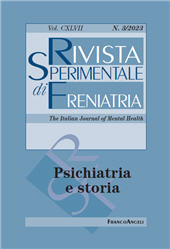Musei della Mente : luoghi e allestimenti per la valorizzazione del patrimonio manicomiale
P. 87-101
Questo articolo si concentra sull'analisi di un particolare tipo di museo, che ho chiamato “museo della mente”. Un museo della mente è un'ex-struttura manicomiale convertita in un museo il cui allestimento, incentrato sulla storia del luogo, presenta una collezione ad esso correlata per narrare e discutere approcci passati e contemporanei alla cura e al trattamento della salute mentale. Tuttavia, un museo della mente non è semplicemente un museo di storia sociale o di storia della psichiatria, né è soltanto un edificio manicomiale restaurato e conservato come museo di se stesso. Si tratta piuttosto di un'istituzione culturale profondamente radicata nel luogo in cui si trova, che lavora con il luogo e il suo patrimonio materiale e immateriale che conserva ed espone, con l'obiettivo di stimolare riflessioni critiche e dibattito sui temi della cura della salute mentale nella nostra società. I musei della mente sono realtà relativamente giovani, attive e vivaci, e in evoluzione.
Spesso molto diversi tra loro sia per quanto riguarda le forme espositive e comunicative adottate sia per le loro pratiche culturali e curatoriali, è tuttavia possibile identificare alcune caratteristiche ricorrenti che accomunano i musei della mente. Queste riguardano sia la loro origine e sviluppo, sia, soprattutto, il loro progetto culturale e comune missione di contribuire a smantellare lo stigma e gli stereotipi ancora oggi associati alla malattia mentale, promuovendo una maggiore consapevolezza e responsabilità sociale riguardo ai temi della cura e del trattamento della salute mentale e delle persone più fragili a causa dei loro problemi psichici. Questo articolo presenta una panoramica critica della nascita e sviluppo di questo tipo di museo per identificare tratti comuni, limiti e potenzialità per i musei della mente contemporanei. [Testo dell'editore]
Asylums have left behind residues and remnants creating the contemporary landscape of the heritage of mental health. This paper focuses on museums that preserve and interpret that heritage. Although public museums were rarely found in a working asylum, forms of public display and collecting were common in these institutions since their inception. In the eighteenth century (and through to the early twentieth in some cases), it was common practice to allow in a paying public in some public madhouses, mad hospitals and asylums as an additional source of revenue. However, visiting the asylum was also meant to be a moral and educational experience, very much in light with the Enlightenment paternalistic attitude.
At Bethlem, ‘the insane were displayed as a didactic spectacle', the viewing was meant to ‘impress the minds and hearts of … visitors' for it was essentially supposed to be a ‘moral experience through turning the mirror.' [1: 183–184]. Precisely because of the moral implications of the spectacle of punishment involved in 18th and 19th century asylum visiting, as well as for the scopic regimes and the subtended power relations characterising asylum life and spaces, the asylum has been discussed in relation to museums and other institutions as part of the ‘exhibitionary complex' [2]. However, while asylums gradually withdrew from the public sphere to become places of incarceration, ‘[t]he institutions comprising “the exhibitionary complex”, [became] progressively more open and public arenas' (ibid.: 74).Asylums and museums constitute ‘different sets of institutions and their accompanying knowledge/power relations, then, whose histories, in these respects, run in opposing directions' (ibid.).
This paper explores how the separated histories of mental asylums and museums eventually re-merged into what I termed ‘mind museums'. A mind museum is a site-specific and place-based cultural institution hosted in the premises of a disused asylum whose work and displays primarily pursue a mission to promote awareness about mental care and treatment in the past and the present, and to contribute to dismantling stigma and stereotypes surrounding mental health today. In this paper I will define in outline a mind museum by tracing its origins within 19th century asylum collecting practices, framing their birth within the deinstitutionalization movement, and eventually discussing their more recent development with particular attention given to exhibition design. The critical analysis of mind museums' exhibition design is here intended not only to describe how mind museums are, but also to understand what they do.[Publisher's text]
Is part of
Rivista sperimentale di freniatria : la rivista dei servizi di salute mentale : CXLVII, 3, 2023-
Articles from the same issue (available individually)
-
Information
ISSN: 1972-5582
KEYWORDS
- riuso adattivo, musealizzazione, ex-manicomi, patrimonio, musei contemporanei
- adaptive reuse, heritage, former asylums, contemporary museums, musealisation


